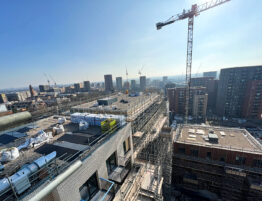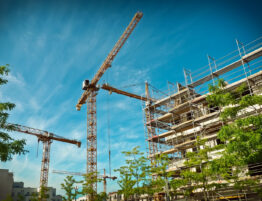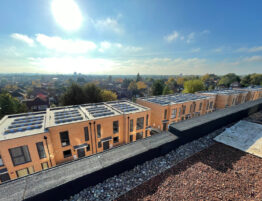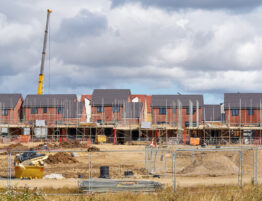
When working on a construction site, actions like lifting, bending, climbing and moving in awkward positions are often part of the everyday job. Because of that, it can be easy to think this kind of work is enough to keep you physically fit.
The fitness industry would disagree – arguing that when people who carry out physically demanding jobs also adopt a structured fitness programme, it can lead to better performance, reduce downtime and extend careers. Find out more about why fitness matters so much and download a sample programme in this week’s blog.
Why fitness really matters in construction
Our workforce is often on their feet all day – lifting heavy materials, carrying tools, twisting, reaching and climbing. Constant physically challenging activity puts the musculoskeletal system under pressure, something that can lead to muscle strain, fatigue, accidents and injury.
Keeping on top of your fitness can help in three key ways:
- Injury prevention: According to fitness experts, training that mirrors the demanding movements of manual work – known as ‘functional training’ – helps to reduce the risk of things like lower back pain, shoulder or knee injuries.
- Health and endurance: Better cardiovascular and muscular fitness means you’re less fatigued by the end of a long shift and more resilient day-to-day.
- Performance and productivity: When the body is fit and well-prepared for the job, the quality and speed of work can improve. For example, someone who has worked on their core stability, balance and functional strength, will likely see the benefits when carrying awkward loads, working overhead or moving materials across the construction site.
What kind of programme should be followed?
Because of the physical nature of construction work, experts advise following a fitness programme tailored to those demands rather than ordinary gym-work that focuses on isolated muscle groups. Below are the five key principles and components of this kind of structured programme.
1. Functional strength movements
These are exercises that simulate what happens on-site, actions like squatting, lifting, carrying, twisting, pushing and pulling. Here are some examples:
| Exercise | Action simulated |
| Squats | Picking up heavy bags/materials from ground level |
| Deadlifts | Lifting heavy loads |
| Overhead press | Lifting/installing materials above shoulder height |
| Farmer’s carry | Carrying toolboxes/materials |
| Pull-ups or rows | Any action requiring upper body pulling strength |
2. Core stability, balance and mobility
Strong core muscles support the spine, which is critical given the bending/twisting on-site. Good balance and mobility mean fewer slips/trips and better capacity to handle uneven terrain or awkward positions.
3. Endurance and cardiovascular fitness
A long day on site isn’t just about lifting – it often involves lots of moving, walking, standing or even climbing. A fitness programme should include endurance and at least moderate cardiovascular work so the body doesn’t tire early.
4. Flexibility and recovery work
Stretching, mobility drills and recovery practices help reduce muscle stiffness, improve joint ranges and reduce the chance of developing chronic issues. For example, doing some simple stretches before a shift on site can significantly reduce injury risk.
5. Work-site practicality
For construction workers looking to get started on a physical fitness programme, it’s also important to manage fatigue and be practical about how your exercise schedule fits in with your working patterns. Something like 2-3 sessions per week might be realistic, allowing time for rest.
DOWNLOAD A SAMPLE ONE-WEEK FITNESS PROGRAMME FOR CONSTRUCTION WORKERS HERE.*
Why this matters for Sheriff Construction and all our teams
Here at Sheriff Construction, we believe that taking care of the body matters just as much as taking care of the bricks and mortar.
For our teams – whose working day often involves early starts, travel time, heavy lifting, awkward movements and the stress of tight deadlines – following a fitness programme aligned with those demands is great for personal wellbeing and makes real business sense.
A fitter-and-stronger workforce means fewer injuries, fewer lost days, better quality of work and longer careers for our people. It’s not about becoming a body-builder – it’s about being fit enough to handle the demands of the job, avoid injury and remain healthy for longer.
What do you think?
Have you tried a functional fitness programme? Or does your site team already do warm-ups and mobility work before a shift? We’d love to hear your thoughts so join the conversation on our Facebook or LinkedIn pages.
06.11.2025
Feature image: Freepik
*Safety Disclaimer
This article and the sample fitness plan is based on Internet research and has not been written by an expert in this field. It is therefore provided for general information and educational purposes only and is not a substitute for professional medical or fitness advice.
Always consult your GP or a qualified fitness professional before beginning any new exercise programme, especially if you have existing health conditions, injuries or concerns.
Listen to your body, progress at your own pace and never push through pain. Sheriff Construction accepts no liability for injury or loss arising from the use or misuse of this guide. Stay safe, train smart and work strong.








